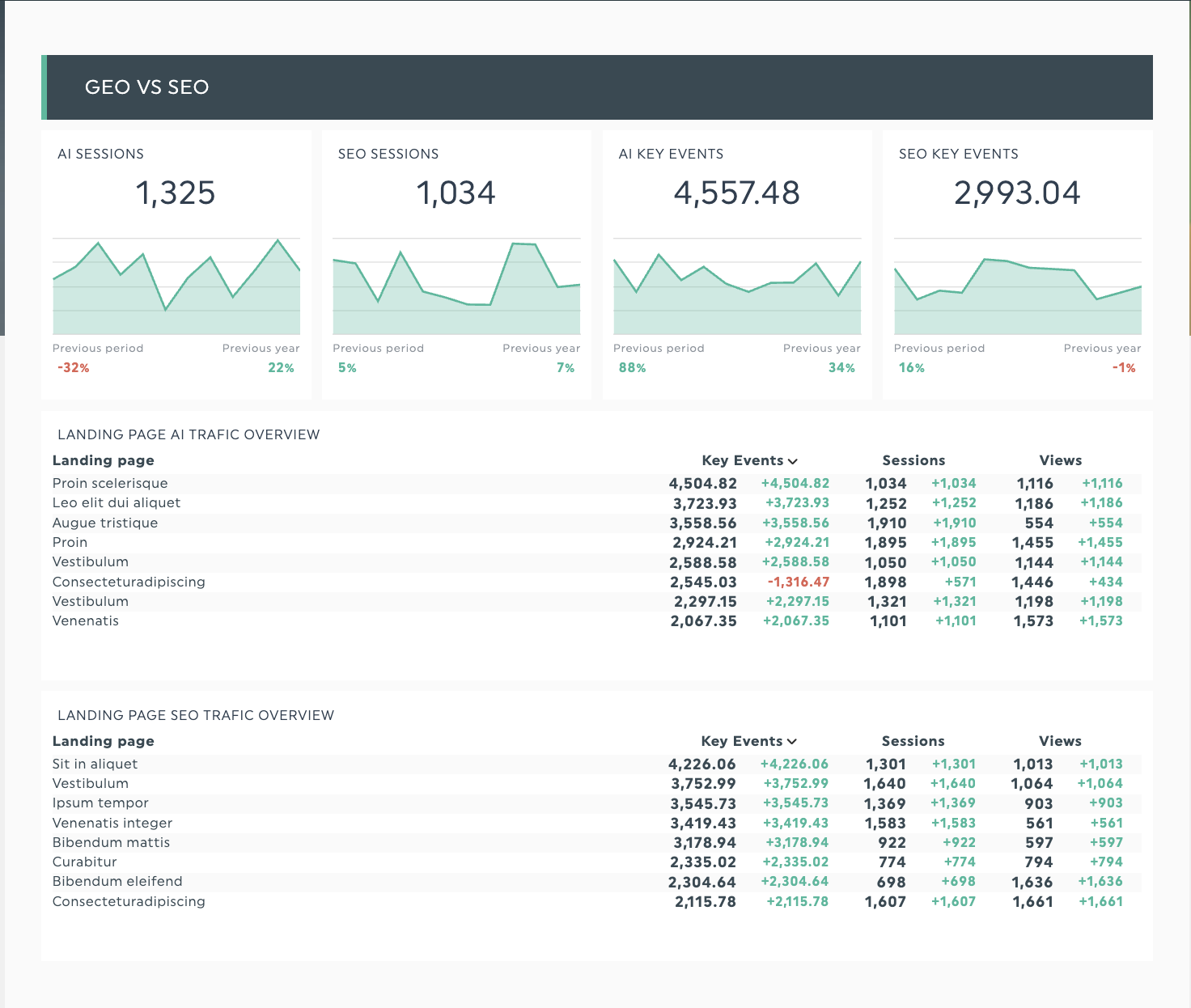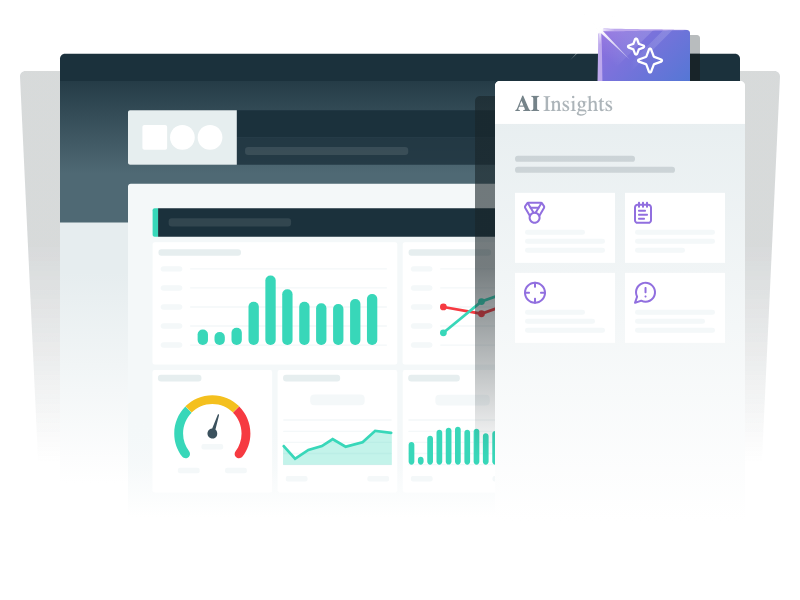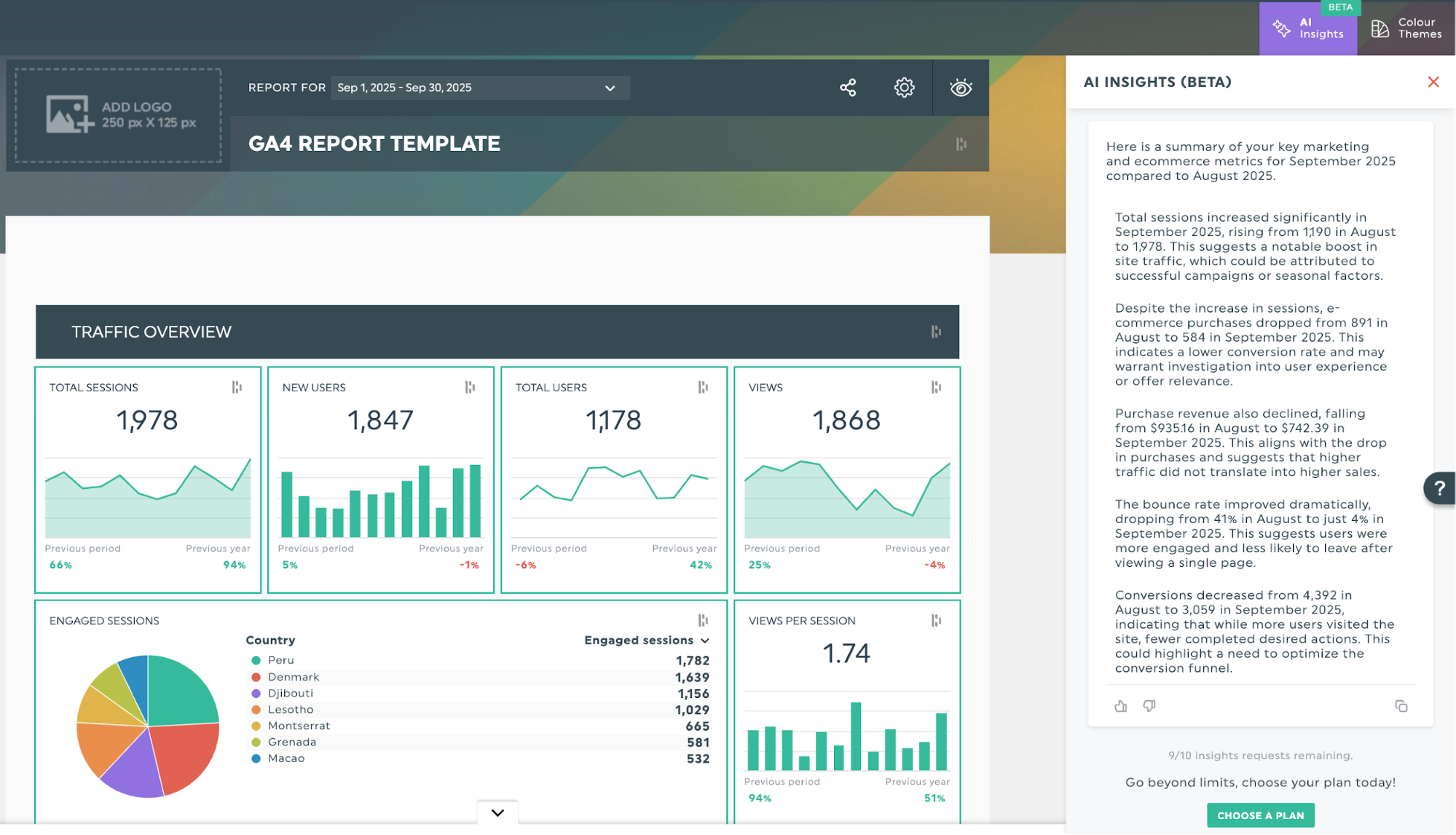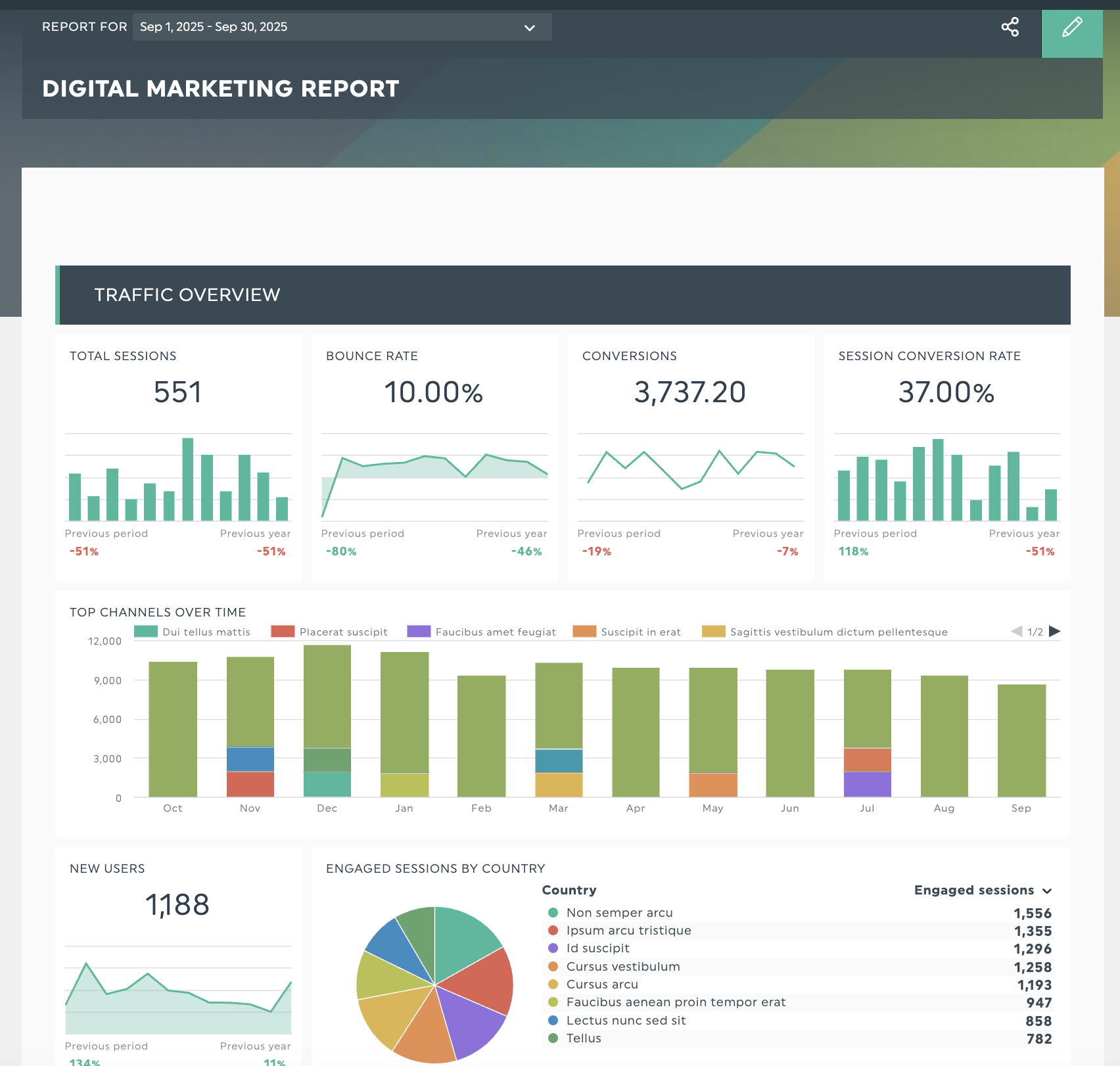How to Use DashThis AI Marketing Reports to Save 10+ Hours Per Week

- What is an AI marketing report?
- Practical applications of AI marketing reports
- A step-by-step guide to analyze campaign performance with AI with DashThis
- Try DashThis to stream your data analysis with AI insights
Could you get back 10+ hours of your week by eliminating manual report creation?
That's what marketers are discovering when they use artificial intelligence (AI) to automate repetitive marketing tasks like data reporting. A 2025 Canva study on AI in marketing showed that marketers save significant time when they automate repetitive tasks with AI.
Instead of spending hours analyzing metrics from platforms like Google Analytics and Facebook Ads, they're using AI chatbots like ChatGPT and Google Gemini to identify patterns and start their data analysis quickly.
Yet despite these clear benefits of AI technologies, many marketing professionals still struggle to get started. The 2025 State of Marketing AI report found that 62% of marketers say they need more education and training before they can effectively use generative AI tools. If you feel uncertain about using AI, you’re in the right place.
This guide will show you how to apply generative AI to marketing data analysis. You'll find practical examples from marketers who use DashThis, along with specific ways AI adoption can streamline your dashboard reporting.
What is an AI marketing report?
AI marketing reports can refer to two areas:
- Reports that track traffic from AI referral sources, including ChatGPT, Microsoft Copilot and Claude
- Using AI to analyze campaign results
While our AI report template tracks traffic from AI tools, this guide focuses on using AI as a competitive advantage to help you analyze and understand your marketing data more effectively to stay ahead of future trends and future-proof your reporting processes.

Get this AI referral traffic report with your own data!
AI marketing reports analyze data through machine learning. This technology uncovers hidden patterns and changes that might escape human review, translating complex findings from multiple channels into clear action steps.

This way, your reports do more than display last month’s metrics. They provide a starting point for your analysis, either by highlighting opportunities in your data or by revealing urgent issues to prioritize in your strategic decision-making.
Instead of spending hours manually analyzing spreadsheets, you can use AI-powered dashboard features in DashThis or run your data through tools like ChatGPT, Perplexity, or Claude - saving you from endless spreadsheet scanning.
Practical applications of AI marketing reports
How does AI help in data analysis? Start with these three examples.
Spot cross-channel opportunities with AI pattern recognition
Today's customers don't stick to one channel while browsing for products to buy. Instead, they jump between social media, email, search, and messaging platforms throughout their e-commerce buying journey. Salesforce reports that customers now discover, buy, and get service across social and messaging channels rather than relying on a single touchpoint.
So, to reach them effectively, your marketing campaigns need to involve different channels relevant to your client’s audience. But, this shift brings a new challenge: making sense of data from multiple formats and sources.
It takes considerable time and effort to review different datasets by hand. AI tools can analyze information from many sources, including website analytics, advertising results, and search engine rankings, to spot important patterns human reviewers might miss.
Tyler Denk, CEO and co-founder of beehiiv, uses AI’s predictive analytics to analyze patterns and spot opportunities across their marketing efforts.
We use AI to make sense of how users behave across all our acquisition channels, whether it’s creator partnerships, paid ads, or organic content. Instead of looking at each channel in a vacuum, the system surfaces patterns and links that you'd never catch just skimming isolated dashboards.
Tyler shared how this analysis uncovered an unexpected pattern: He says:
The AI platform picked up on a trend we hadn’t noticed. Users coming in through newsletter swaps were showing higher lifetime value than those from Meta ads, but only if they signed up via a specific group of landing page variants. That insight was buried under layers of attribution complexity. Honestly, there’s no way we would’ve spotted it manually.”
AI helped his team identify an opportunity for channel optimization. Tyler says: “Once we saw the data, we moved quickly. Within a week, we shifted about 20% of our ad budget toward those high-performing variants and doubled down on the creators driving that traffic. We got a clear boost in retention and a noticeable uptick in paid conversions.”
Tyler's AI analysis revealed cross-channel patterns he never would have caught manually. Hidden connections between different data sources suddenly became clear, the kind of insights that would take weeks to spot by hand, if at all. This matters most when customers bounce between multiple touchpoints before buying.
Customer acquisition costs become difficult to measure when buyers engage with multiple touchpoints, such as Facebook ads and email campaigns, before making a purchase. The complexity of calculating lifetime value multiplies across fragmented customer journeys—from initial social media discovery through email nurturing to final conversion.
Support the human data analysis process
Data analysts at all skill levels face potential pitfalls that can affect their conclusions. Here are key analytical errors to avoid:
- Confirmation bias: Limiting your analysis to data that supports your initial assumptions - like tracking rising engagement numbers while ignoring actual sales conversions.
- Taking data out of context: Raw data can mislead when separated from business realities. Numbers that appear impressive by themselves may reveal different insights once examined holistically. Consider this analytics scenario: A website records a 50% increase in referral visitors in a weekly report—an encouraging surface metric. Yet with conversion rates dropping 30%, the company actually generated fewer qualified leads compared to pre-spike levels.
- Dismissing outliers too quickly: Many analysts automatically remove unusual data points to keep reports looking clean. But sometimes these ‘odd’ numbers reveal critical issues. For example, suppose website traffic suddenly drops 40% on mobile devices while desktop traffic remains stable. In that case, this outlier likely shows a technical problem with your mobile site rather than bad data that should be filtered out.
AI identifies patterns in historical data and strengthens analysts’ work. Technology enhances analysis, but your expertise remains crucial - you understand the context and relevance needed to make wise strategic choices aligned with client goals.
The key is striking the right balance between human judgment and AI capabilities when analyzing data to inform your client’s marketing strategy. Ankush Chowdhury, the Founder of Humanizer AI, describes his AI-driven data analysis workflow as a tool of guidance.
“I utilize AI as a tool of guidance, not definitive authority. For instance, when preparing revenue forecasts, AI presents a series of growth scenarios, which I adjust based on industry benchmarks and understanding of customer behavior. AI simply gets me through the speed of options, but nothing is finalized or agreed upon without all final options being a human judgment. Stakeholders see that balance, which continues the trust in the process.”
Save time on manual reporting
If you're like most marketers, you know the Monday morning routine: pulling data from Google Analytics, Facebook Ads, your email platform, and piecing it all together into something coherent. All these manual steps take time, and you spend hours wrestling with CSV files and mismatched data formats.
Creating client reports typically takes five to ten hours. By letting DashThis’s AI tools focus on meaningful work, such as checking data accuracy and crafting recommendations that align with client goals. AI tools give marketing teams a competitive advantage in their workflow..
When Jeremy Feig at CRO:NYZ Digital tried our AI insights tool, he discovered:
“The AI came to many of the same conclusions that we had. Plus, it "thought of" some other insights that we’d missed — and they were accurate, quality insights.
The summaries would also call out specific data points to support the the given analysis. And as a nice touch, it often (though not always) referenced what specific widget it had analyzed the data from. This was very helpful, allowing us to double-check the conclusions that had been drawn.
A step-by-step guide to analyze campaign performance with AI with DashThis
DashThis’s AI-powered analytics tools uncover patterns in your data, providing reliable foundations for analysis while saving time on repetitive tasks. Here’s how to start.
First, sign up for your 14-day DashThis free trial. Once you’re ready, follow these steps.
- Choose from these reporting templates, or create your own.
- Connect your marketing data from popular platforms like GA4, TikTok, Mailchimp, and Instagram Ads
- Arrange widgets as needed, or design your own visuals to showcase your findings best
After building your dashboard, tap into DashThis’s AI insights to spot key patterns and kick-start your analysis. For example, you could use it to get a quick summary of your data, or highlight wins and issues present in the data to investigate further. Let's look at how this works in practice with Google Analytics 4 data.
Start your GA4 reporting and analysis with a clear data overview
Google Analytics 4 is packed with 100+ metrics and dimensions to analyze user activity throughout the entire user journey and optimize your website and app for engagement. Overwhelming, right?
When you're staring at countless possible digital marketing insights, knowing where to start your analysis can feel daunting. That's where DashThis's AI summary feature shines. Instead of manually combing through every metric, the AI instantly compares this month's performance against the previous month. It gives you that crucial first read on your data, a starting point for deeper data analysis.

Get this GA4 dashboard template with your own data!
Use the digital marketing template to compare metrics across channels
Preparing for a budget review with your client? Compare marketing channel performance across metrics like engagement rates, ROAS, and how well spend drives revenue.
DashThis's AI simplifies reporting with two key views. The Issues lens identifies problems that need quick fixes, while the Wins view highlights your top-performing campaigns.

Get this digital marketing dashboard template with your own data!
Try DashThis to stream your data analysis with AI insights
Marketing reports help you understand your clients’ data, but AI support enables you to focus on more valuable work, like adding context and providing specific recommendations. The use of AI in marketing reports does more than automate data collection. They reveal patterns that manual analysis misses. Whether you’re spotting cross-channel opportunities, getting objective analysis, or saving hours on reports, AI helps you work more efficiently.
Use DashThis's AI analysis tools to check your data findings or discover new trends. Connect your data sources, review the results, and engage in better client conversations with AI-supported recommendations.
Start your free 14-day trial of DashThis and build your first AI marketing report today.
Ready to use DashThis AI marketing reports?
Read More
Don’t miss out!
Automate your reports!
Bring all your marketing data into one automated report.
Try dashthis for free

